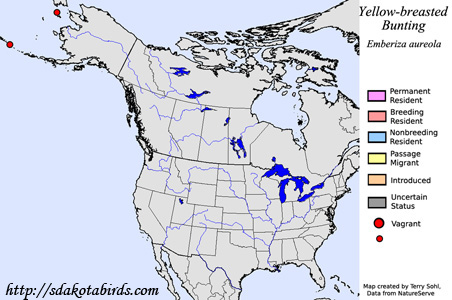Yellow-breasted Bunting
Emberiza aureola
| Length: 5.5 inches | Wingspan: 8.5 inches | Seasonality: Non-resident in South Dakota |
| ID Keys: Male: Dark chestnut upperparts, black head, yellow below with dark flank streaks, chestnut chest band | ||
 The
Yellow-breasted Bunting is normally found in eastern Europe and Asia, but it
has been found on very rare occasions in islands off the west coast of
Alaska. It is a poorly-understood species. At the start of the
21st century, they were considered a species of "Least Concern" by the IUCN,
with no indications of widespread population issues. Since then, it
has become apparent that the species is in very rapid decline and
populations were not as large as once believed. Since 2004 the species
has moved from "Least Concern" to "Vulnerable" to "Endangered", on the IUCN
watch list. While some of the decline has been attributed to habitat
loss, particularly in their wintering range in southeast Asia where land has
been converted to intensive agricultural use, the majority of the decline is
likely due to direct capture of the birds. In parts of southeast Asia,
Yellow-breasted Buntings and other songbirds are caught in large numbers in
mist nets, and sold as food.
The
Yellow-breasted Bunting is normally found in eastern Europe and Asia, but it
has been found on very rare occasions in islands off the west coast of
Alaska. It is a poorly-understood species. At the start of the
21st century, they were considered a species of "Least Concern" by the IUCN,
with no indications of widespread population issues. Since then, it
has become apparent that the species is in very rapid decline and
populations were not as large as once believed. Since 2004 the species
has moved from "Least Concern" to "Vulnerable" to "Endangered", on the IUCN
watch list. While some of the decline has been attributed to habitat
loss, particularly in their wintering range in southeast Asia where land has
been converted to intensive agricultural use, the majority of the decline is
likely due to direct capture of the birds. In parts of southeast Asia,
Yellow-breasted Buntings and other songbirds are caught in large numbers in
mist nets, and sold as food.
Habitat: During the summer breeding season, Yellow-breasted Buntings are found in marshes and wet meadows, particularly those with tall herbaceous vegetation and scattered shrubs. They can be found in a wider variety of habitats during migration and the winter months, including grasslands, wetlands, and agricultural land.
Diet: Feeds heavily on seeds, but will also take insects and other small invertebrates, particularly during the breeding season.
Behavior: Most feeding is done on the ground or low in vegetation.
Nesting: The nest is a cup made of grasses, lined with finer grasses and animal hair. The nest is placed close to or on the ground, such as in a shrub or on the ground in a tussock of vegetation. The female lays between 3 and 5 eggs, and both parents help to incubate them. Both parents help feed and tend the young, once the eggs hatch.
Song: A clear warble of distinct phrases.
Migration: Migratory. Yellow-breasted Buntings breed in far eastern Europe (Finland, Belarus, Ukraine) and in Russia, northern Japan, and Mongolia. Wintering birds are primarily found in southern Asia.
Feeders: Will attend feeders for millet, peanuts, and suet.
Interactive eBird map: Click here to access an interactive eBird map of Yellow-breasted Bunting sightings
Similar Species: Distinctive if seen well.
Conservation Status: Populations have been in sharp decline in recent years. The IUCN lists the Yellow-breasted Bunting as an "Endangered" species.
Further Information: 1) BirdLife International - Yellow-breasted Bunting
2) WhatBird - Yellow-breasted Bunting
3) Beauty of Birds - Yellow-breasted Bunting
Photo Information: Public Domain image.
| Click below for a higher-resolution map |
 |
| South Dakota Status: Non-resident in South Dakota |
Additional Yellow-breasted Bunting Photos (coming soon!!)
